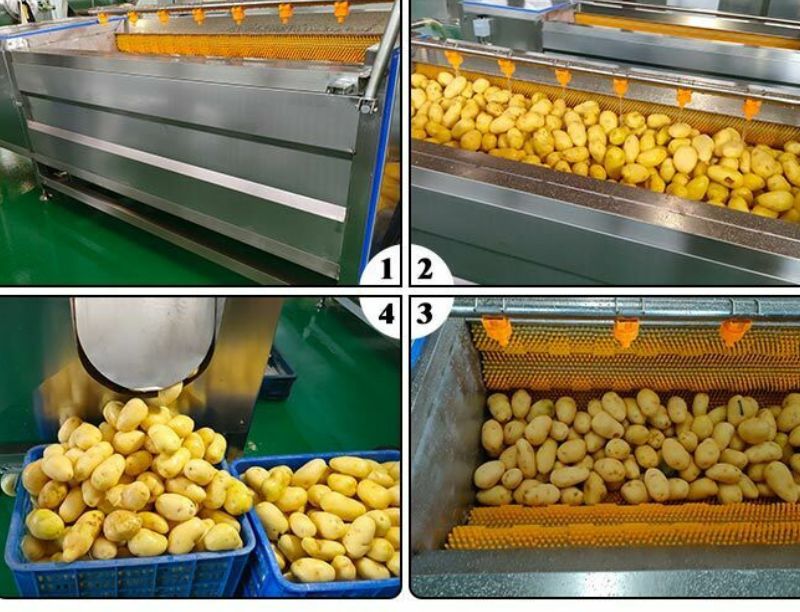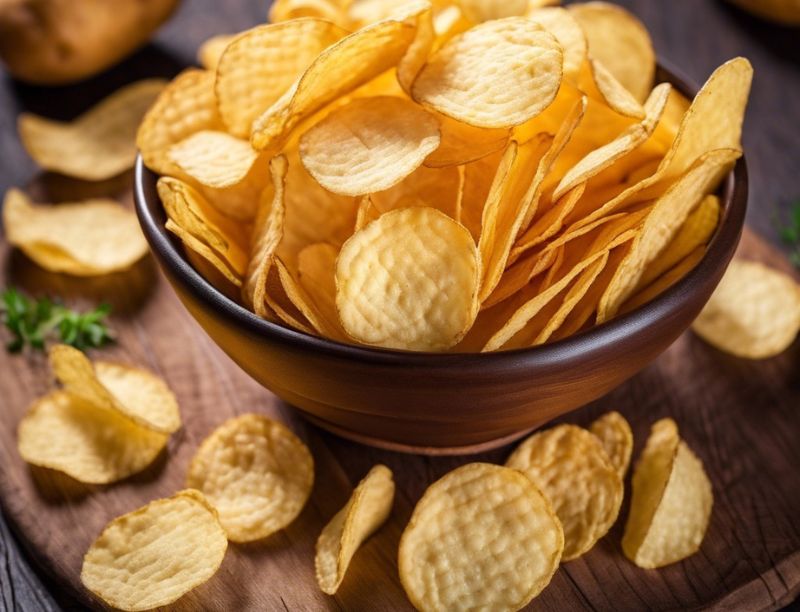Introduction
Potato chips are one of the most popular and universally loved snacks. They are crispy, flavorful, and versatile, making them a staple at parties, picnics, and casual gatherings. This article delves into the history, production process, nutritional aspects, popular flavors, and global influence of potato chips while highlighting their cultural significance.
A dissatisfied customer kept returning fried potatoes, complaining they were too thick. To retaliate, Crum sliced the potatoes very thinly, seasoned them with salt, and cooked them till crisp. Surprisingly, the customer loved them, and the potato chip was born.
Initially known as “Saratoga Chips,” these crispy delights gained popularity in the United States and eventually around the globe. By the early 20th century, commercial production began, revolutionizing the snack industry.
The Potato Chip Production Process
- Raw Material Selection: The first step in making potato chips is selecting the correct type of potato. Varieties with a high starch content and low moisture, such as Russet or Maris Piper, are ideal for achieving the perfect crispiness.
- Washing and Peeling: Potatoes undergo a rigorous washing process to remove dirt and debris. Then, they are peeled using mechanical peelers or steam to ensure a smooth surface.

- Slicing: The peeled potatoes are sliced into thin, uniform slices. The thickness is crucial as it impacts the texture and cooking time of the chips.
- Washing and Blanching: The slices are rewashed to remove excess starch and then blanched in hot water. Blanching helps achieve a consistent color and texture in the final product.
- Frying: The potato pieces are fried in hot oil, typically 150–180°C. The frying process removes moisture, giving the chips their characteristic crunch.
- Seasoning: The chips are seasoned with salt, spices, or flavorings immediately after frying. The seasoning adheres better when the chips are still warm.
- Packaging: Once cooled, the chips are packed in air-tight bags to maintain freshness. Nitrogen gas is often added to the packaging to prevent oxidation and extend shelf life.
Nutritional Aspects of Potato Chips
Potato chips are undeniably delicious, but they are also calorie-dense. Here’s a breakdown of their nutritional profile:
- Calories: A standard serving of 28 grams contains around 150-160 calories.
- Fat: They are high in fat, especially fried, with about 10 grams per serving.
- Carbohydrates: Chips are a significant source of carbohydrates, primarily from the potato itself.
- Protein: They contain a small amount of protein, typically around 2 grams per serving.
- Sodium: Potato chips are often high in sodium due to added salt, which can contribute to hypertension if consumed in excess.
Although potato chips are not the healthiest snack, moderation is vital. Baked or air-fried alternatives offer a lower-calorie option for health-conscious consumers.
Also Read: Chatpate Recipe: A Tangy Delight
Popular Potato Chip Flavors
Potato chips come in various flavors to cater to diverse palates. Some of the most popular flavors include:
- Classic Salted: The original and timeless flavor is perfect for purists.
- Sour Cream and Onion: A tangy and creamy favorite.
- Barbecue: Sweet, smoky, and slightly spicy.
- Cheddar Cheese: Rich and cheesy, loved by cheese enthusiasts.
- Salt and Vinegar: A sharp and tangy option for bold flavor seekers.
- Chili and Lime: A zesty combination with a spicy kick.
- Spicy Jalapeño: A fiery choice for heat lovers.
Regional flavors, such as Masala in India, Kimchi in Korea, or Prawn Cocktails in the UK, reflect local culinary traditions and tastes.
Potato Chips Around the World
Potato chips have transcended borders, becoming a global phenomenon. Each region adds its unique twist to this classic snack:
- United States: Home to some of the largest potato chip brands, such as Lay’s and Pringles, the U.S. offers many flavors and innovative packaging.
- United Kingdom: Known as “crisps,” British versions often include unique flavors like Roast Chicken or Worcestershire Sauce.
- Japan: Japanese potato chips are known for their adventurous flavors, including Wasabi, Nori Seaweed, and Chocolate.
- India: Indian brands like Uncle Chips and Balaji cater to local tastes with spicy and tangy options like Masala or Tandoori.
- Australia: Smith’s Chips dominates the market with flavors like BBQ Ribs and Honey Soy Chicken.
Potato Chips and Cultural Significance
Not only are potato chips a snack, but they have cultural and social significance. They are a staple at parties, game nights, and family gatherings. Potato chips are also associated with comfort food, providing a sense of indulgence and nostalgia.

Advertising has played a significant role in elevating the status of potato chips. Memorable campaigns like Lay’s “Betcha Can’t Eat Just One” have cemented their place in popular culture.
Innovations in Potato Chips
Over the years, the potato chip industry has witnessed remarkable innovations:
- Baked Chips: A healthier alternative with reduced fat content.
- Kettle-Cooked Chips: Thicker and crunchier chips made using traditional methods.
- Veggie Chips: Made with sweet potatoes, beets, or kale for added nutrition.
- Flavored Powders: Advanced seasoning techniques ensure every chip is evenly coated.
- Eco-Friendly Packaging: Many brands are adopting sustainable packaging to reduce environmental impact.
Making Potato Chips at Home
Making your potato chips is simple and allows for customization. Here’s a simple recipe:
Ingredients:
- 3 large potatoes
- Salt
- Oil for frying
- Optional seasonings: paprika, chilly powder, garlic powder, or cheese powder
Instructions:
- Slice potatoes thinly using a mandoline or knife.
- Soak slices in cold water to remove starch.
- Dry the slices thoroughly with a kitchen towel.
- Heat a deep pan’s oil and fry slices in batches until golden.
- Remove and drain on paper towels.
- Sprinkle with salt and desired seasonings. Enjoy!
Potato Chips: Economic Impact
The global potato chip market is a billion-dollar industry. Recent data indicates that the market is expected to expand steadily, driven by urbanization, changing lifestyles, and innovative flavors. Leading brands like PepsiCo (Lay’s) and Kellogg’s (Pringles) dominate the market, while local brands cater to regional preferences.
Conclusion
Potato chips have come a long way from their humble beginnings in a small kitchen. Today, they are a universal snack that bridges cultures and brings people together. Potato chips remain a beloved treat whether you prefer plain, spicy, or gourmet. As the industry continues to innovate, there’s no doubt that our love for these crispy delights will only grow stronger.
So, the next time you enjoy a bag of chips, remember the rich history and craftsmanship that goes into creating this timeless snack.
Read More: Kurkure Chaat: A Perfect Fusion of Crunch and Flavors

